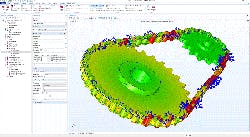Comsol announces the latest version of its Comsol Multiphysics software. In version 5.5, the Design Module provides an entirely new sketching tool for easier creation and more versatile parametric control of geometry models. New and updated solvers speed up a wide range of simulations. Two new add-on products, the Porous Media Flow Module and the Metal Processing Module, further expand the product suite's multiphysics modeling power.
Ultrasound technology is becoming increasingly important in a wide range of applications spanning from process engineering and nondestructive testing to consumer electronics. New functionality based on the time explicit discontinuous Galerkin method enables efficient multicore computations of ultrasound propagation in solids and fluids, including realistic materials featuring damping and anisotropy. The method also has low-frequency applications, such as in seismology. The included multiphysics capabilities can seamlessly combine linear elastic wave propagation in a solid and its transition to a fluid as an acoustic pressure wave, and back again. The new elastic wave functionality is available for users of the Structural Mechanics Module, MEMS Module, and Acoustics Module. The fluid-structure acoustics coupling is available in the Acoustics Module.
For frequency-domain simulations, a specialized solver for wave propagation analysis makes it possible to handle higher frequencies (shorter wavelengths) using the finite element method. The new solver can be used to analyze enclosed structures such as that of a car cabin interior as well as other acoustics simulations.
The new Metal Processing Module makes metal phase transformation analysis accessible within the Comsol Multiphysics environment for applications within welding, heat treatment and metal additive manufacturing. The Porous Media Flow Module gives users within, for example, food, pharmaceutical and biomedical industries, a wide range of transport analysis capabilities for porous media. The new add-on product includes functionality for single- and multiphase flow in porous media, drying and transport in fractures. The flow models cover linear and nonlinear flow in saturated and variably saturated media with special options for slow and fast porous media flows. The multiphysics simulation capabilities are extensive, with functionality that includes options for calculating effective thermal properties for multicomponent systems; poroelasticity; and transport of chemical species in solid, liquid, and gas phases.





